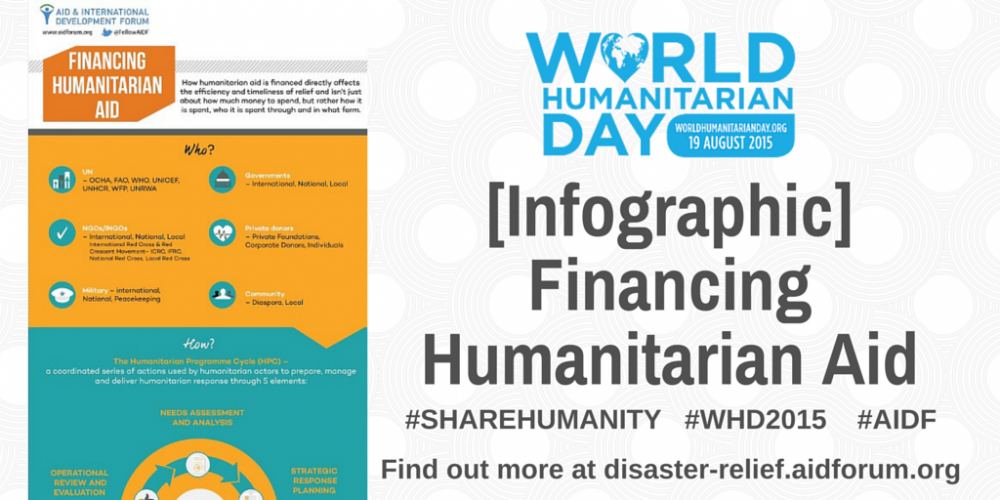Global Disaster Relief Summit Working to Continue the Efforts of World Humanitarian Day

“In a world that is ever more digitally connected, each of us has the power and responsibility to inspire our fellow human beings to act to help others and create a more humane world.”
UN Secretary-General Ban Ki-moon
World Humanitarian Day is a time to recognize those who face danger and adversity in order to help others. The day was designated by the General Assembly to coincide with the anniversary of the 2003 bombing of the United Nations headquarters in Baghdad, Iraq. World Humanitarian Day is also an opportunity to celebrate the spirit that inspires humanitarian work around the globe.
The theme for this year is #ShareHumanity. In the light of the World Humanitarian Day, the Aid International Development Forum (AIDF) is highlighting the importance of knowledge transfer, best practice and technological innovations to help save lives during and after disasters.
Science and technology have the potential to dramatically improve humanitarian aid and disaster response - the solutions span from wearable technology and 3D printing to cutting-edge innovations in basics such as sanitation, shelter and nutrition.
Now more than ever governments, military & defence units, NGOs, UN agencies, multilateral organisations, media and the private sector must work together to provide much needed humanitarian and disaster relief. But especially with disasters becoming ever more complex and unpredictable how can those stakeholders best coordinate their efforts, and ensure a fast and effective delivery of goods, funds and expertise? How can they make the most out of modern technologies and information networks; and gain a better understanding of the disaster situation and communicate more efficiently with each other? How can they ensure safety of everyone involved in the field?
To address those issues AIDF is hosting its 7th annual Global Disaster Relief Summit on the 10th and 11th of September 2015 at Ronald Reagan Building and International Trade Center in Washington D.C.
During the two-day summit, over 250 international experts will gather to discuss how technological innovations and best practices can assist in disaster response and aid delivery in more effective, sustainable and cost-efficient way. AIDF has developed the agenda in consultation and research with key organisations, such as WFP, UNOCHA, World Vision International, USAID, Red Cross organisations, IOM, World Bank, UNHCR, UN Procurement.
This year’s programme focuses on best practice in humanitarian logistics (including transport, procurement, supply chain management), strategic partnerships, financing, security (especially in the Middle East and Africa), emergency coordination and communication, emergency WASH, lessons learned from Ebola outbreak, communication with communities, shelter assistance, electronic payment models, data collection and management.
A wealth of speaker such as Carlos Carrazana, Executive Vice President & COO, Save the Children USA; Dmitri Dovgopoly, Director, UN Procurement, David Megginson, Chief Architect for Data Analysis, OCHA, Peter Murphy, Regional Security Advisor, Africa, Bill & Melinda Gates Foundation, and Gianluca Bruni, Chief Emergency Telecommunications Cluster, WFP will share their expertise in overcoming these difficulties. To register or find out more you can visit http://disaster-relief.aidforum.org/.
To celebrate World Humanitarian Day and promote this year’s theme of #SHAREHUMANITY; we have released an infographic using facts to demonstrate the complexities in financing humanitarian aid. Highlighting how the efficiency of humanitarian aid and disaster relief efforts is directly affected by the way they are financed. AIDF’s infographic shows that it is not only about how much should be spent on aid, but rather how the money is spent, who it is spent with and in what form.
From 1999 to 2010, the international community provided $3.3 trillion in aid. Of this, $106.7 billion was spent on disasters, and just $13.5 billion (12.7% of disaster funding) went to disaster risk reduction and preparedness. AIDF’s infographic clearly shows the undersized proportion of disaster financing and draws the comparison between this and the huge amounts spent on reconstruction, rehabilitation and response.
You can download a full infographic below.









